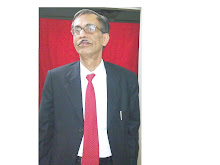Gita: Identifying the Creator
Gita’s simple and abstract concept of God did not reveal itself suddenly one day during 2500-5000BC. It quite probably evolved through centuries of quest by the thinking men and women. They were awed by the great diversity of inanimate objects and living beings in the environment around in the land, water, fire breeze, storm, sky, day and night, hunger and pleasure, peace, conflict and rivalry, sun, moon and the stars, the mountains, the trees and woods, the rivers and the seas as also the continuous change in the environment including the climate and the temperature. They wanted to know who would have created all this. Their quest for knowledge about the Creator through observations and application of logic led them to the following conclusions about the Creator:
1. Unique Creator (multiple Creators would have led them to search for the Creator or Creators; so single creator would be the ultimate)
2. The question of who created the Ultimate Creator was illogical therefore by definition (the word ultimate stops one from going beyond)
3. If the concept of Ultimate Single Creator is accepted, then no one created the Ultimate Creator: hence He is ageless, limitlessly old, was never born, was never dead, never ceased to exist, therefore He is inexhaustible, indestructible and always present.
4. Since observations showed that all new things that emerge owe their origins to some one or more source/s (seeds grow into plants), the properties of any part of the creation must have been imparted by the source/ origin (fish cannot start swimming, birds cannot start flying, drops of rain cannot stop falling mid-way in the sky, the Sun cannot stop emanating light unless these properties were inherent in the source from which they came into being). If everything did not come out of nothing but emerged out of something through transformation from one or more sources that existed before, the transformation process would have passed on the properties of old source/s to the new one that they gave rise to. Thus the ultimate Creator being the Ultimate Source, the Creator must have contained all the properties of all that is in the Creation (including all transformation/ creative/ destructive processes) that we come to know or yet to know.
5. If the Creator as the Ultimate Source contains all the properties of all that is and will be in the Creation, the Creator is present in all parts of the creation and hence everything contains Him in this sense, though we cannot identify Him separately in each of his creation. Each part of the creation therefore contains Him: even if each part is further decomposed in to smaller parts, He still exists in each of the smaller parts. So, the Creator is in this sense indivisible even if the Creation has so many parts, elements and processes.
6. If the Creator is present in each of the infinitesimal parts of the Creation, this amounts to accepting that the entire Creation is contained in the Creator.
7. Apparently, 5 and 6 seem contradictory. But given the assumptions of (a) the Ultimate-ness of the Creator and (b) transformation of properties from source/ origin to the transformed new creation (new parts at any point of time – like a human at birth or the clouds and rain or a new species or a new thought, a new weapon, an invention), both 5 and 6 are mutually consistent. God as the Creator is contained in us and all of us are contained in the Creator. So, God is all-pervasive.
8. Given the instruments of scientific testing of Truth that the thinkers had during 2500BC to 10,000 BC (and probably even now), there was no way to test the Truth contained in 5,6 and 7 empirically. If the assumptions held good, the theory contained in 5,6 and 7 held good as well by logical deduction and induction.
9. The parts in the Creation are numerous, uncountable. This was easily testable empirically. If the Creative and Destructive processes were part of the overall Transformation process that relates all origins/ sources to their transformed output and the transformation process did not seem to end, the Creator is Infinite to the human senses.
10. Since the Creator is infinite, so is the Creation as the entire Creation is contained in the Creator and the Creator is present in each part/ component/ process/ element/idea of the Creation and as of the time when Gita had been uttered by Lord Krishna (who is Krishna is a separate issue) there was absolutely very little knowledge of the diversity and dimensions of, and the processes that goes on in the Universe, the Creator was incomprehensible and unexplainable (Science has progressed much since the days of Lord Krishna and yet the Universe is far from being comprehensible and explainable in the entirety: there are more questions to which answers are being sought by scientists today to explain the Universe than the number of questions that occurred to human being at any point of time in the past).
We have got some idea as to how the abstract concept of Unique, all-pervasive, omni-present, infinite, ceaseless, inexhaustible, indestructible, everlasting, incomprehensible, unexplainable, unalterable God evolved through scientific pursuit of the knowledge about the Creator and the Creation through observations and logical reasoning.
The Question that arises now is to what use did the Gita put this simple, abstract concept of God, especially when competing theories of God already existed in that ancient ages ? That is what we may try to explore next.
Subscribe to:
Post Comments (Atom)

No comments:
Post a Comment